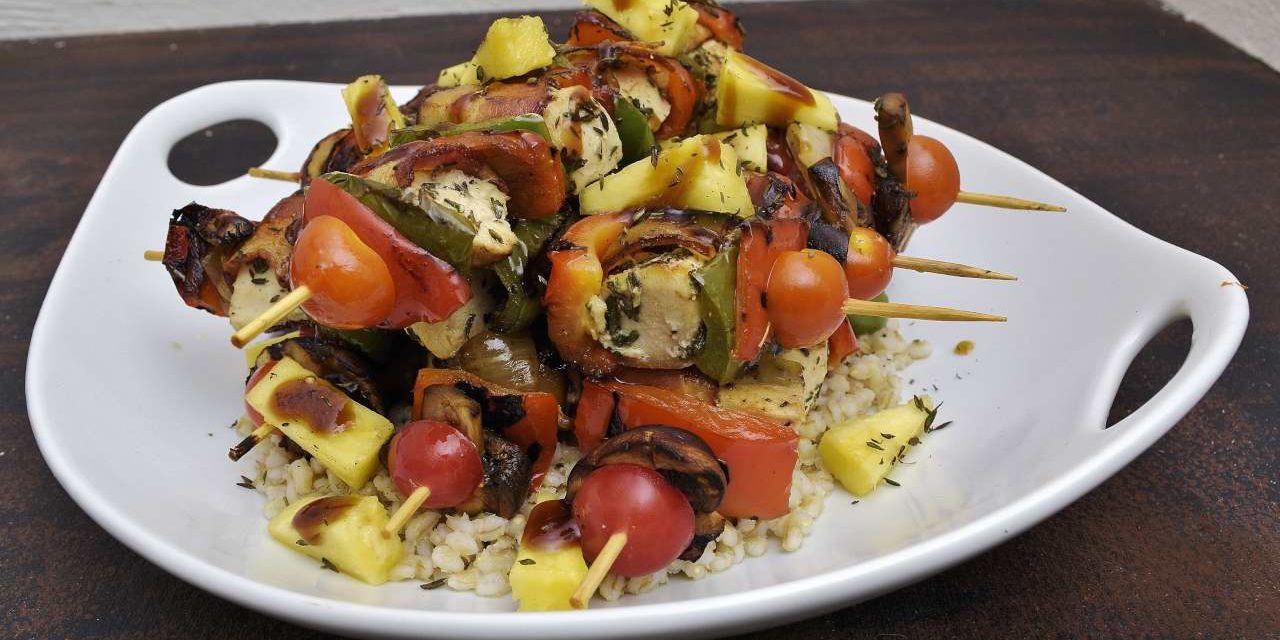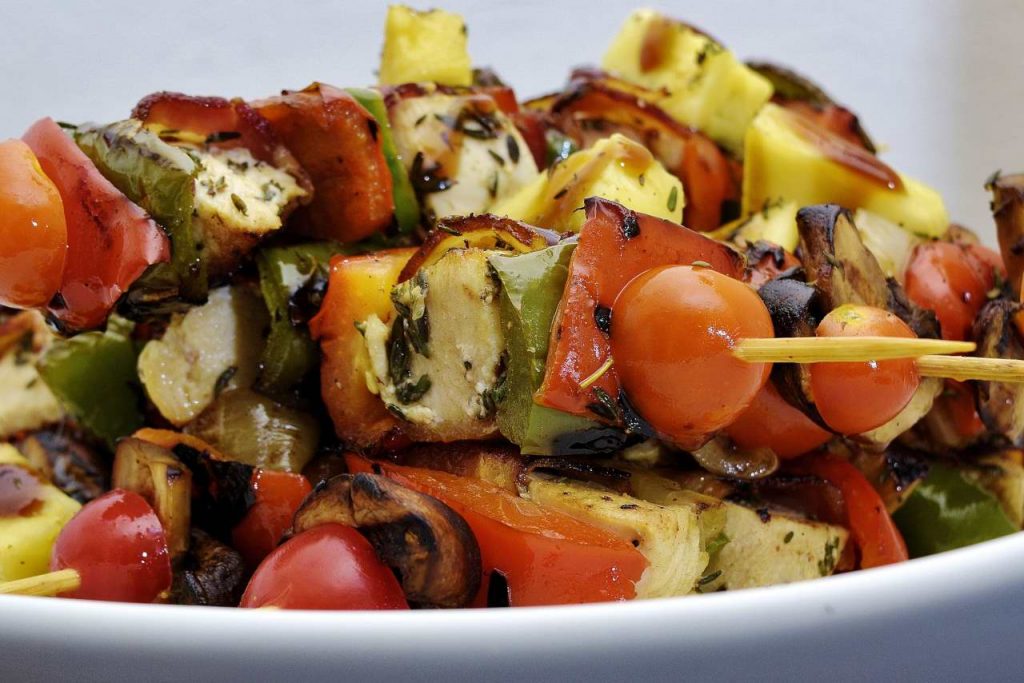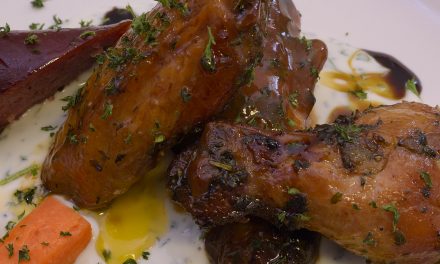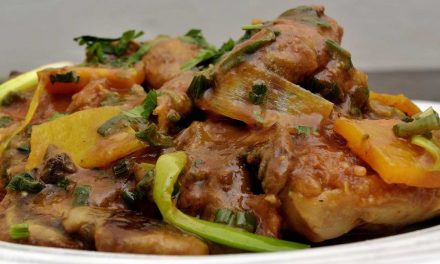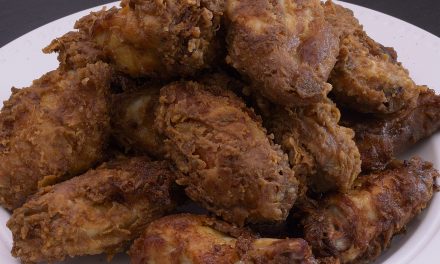Bamboo stick to your principles.
Almost every ambitious home cook has impaled raw meat and vegetables on a stick in an effort to bring a little bit of gleam to a dinner party or barbecue. The solemn yet festive off-loading of the food from the otherwise useless skewer evokes primal memories of the ancient hunt and the blazing communal fire depicted in cave-man movies.
Once the painstaking assembly is completed, the looming challenge is to grill these disparate ingredients in such a way that they all achieve the same degree of doneness simultaneously. The cavemen were not able to accomplish this, and not much has changed. Proteins require different temperatures and cooking times than vegetables. You can’t learn much about sous vide without discovering this.
Just how hot is it, Ed?
A piece of beef cooked to 129 F/54 C will be “medium rare.” An onion or pepper cooked to 129 F/54 C is still quite raw. Even if you cook the meat to 165 F/74 C, “well done,” that adjacent veggie will still not have denatured. Vegetables in general require temperatures of at least 183 F/84 C in order to achieve the texture that most people perceive as being “cooked.” If you should attempt to skewer a couple of cherry tomatoes along with everything else on that brochette, well, let’s just say it isn’t going to end well.
The glossy pictures in magazines and foodie websites add those tomatoes to the skewer after everything else is done–thus fulfilling the requirement for the presence of RED. But isn’t that like, um, cheating? Well, it would be if there was an alternative. No matter how you move those sticks around over the heat source, there is no way to crisp that bacon wrapped piece of meat without ruining the tomato. Similarly, if you don’t partially cook the bacon before assembling the brochettes, its crispness will be sacrificed in exchange for that loose, rubbery greasy sensation. This is actually a hint of things to come.
Don’t let the chef see you do this.
The typical hack solution for this in restaurants is to mark the surfaces the best you can and then just throw the whole thing in the deep fryer. Next time you order a brochette in a restaurant, take a gander at it and think about what I just said. Is it shiny and evenly cooked all around? That’s what we call a brain worm.
Everything we knew was wrong. Again.
It’s time to abandon yet another romantic notion. If you can’t make your kabob come out right starting from raw, what do you do? Let’s deconstruct the whole model and begin again. How do we get bacon, chicken, beef, mushrooms, onions, peppers etc. to arrive at the same degree of doneness at some magic moment? Instead of dwelling on the process, let us focus our attention on results.
Take a breath, shake the cramps out of your hands, relax your shoulders and allow the creative juices to wash over you. Let’s ask ourselves. How do we want everything to LOOK? The vegetables should appear to have been grilled, because, well, they ARE. Unfortunately, the act of skewering forces them to stand on their edges, another obstacle.
Spoiler alert:
Grill the vegetables first, cool them off, and then put them on the skewers. Hmmm.
But wait.
Okay, sure, you can partially cook the bacon too before using it to wrap, that will make it easier to crisp. A lot of us are already familiar with that trick. But what about the protein itself–the beef, chicken, lamb, etc.?
Before sous vide, attempting to cook the proteins first would have been a recipe for disaster–the end result would be dryly mediocre at best. Be it chicken, beef, or pork, the meat must be hot without drying out. Here’s the shocker.
Today’s forecast: delightfully moist.
Sous vide processing provides us with a product that mimics uncooked protein even though it is fully pasteurized. Sous vide processed proteins retain their moisture even if the retherming process ends up exceeding the original sv target temperature. Nobody believes this until they actually experience it themselves. No other cooking process can promise this. Sous vide turns the idea of “leftovers” on its head like one of those muscle bound wrestlers from WWE Smackdown.
Ingredients:
Chicken breast, skinless, 2 lbs/900 g.
Powdered egg white, as needed, or fresh, 2 each.
Kosher salt, 1 T.
Black pepper, ground, as needed.
Bell pepper, green, 2 each.
Bell pepper, red, 2 each.
Onion, medium, 1 each.
Mushrooms, fresh, 8 oz/200 g.
Bacon, 1 lb/450 g (about 14 pieces).
Cherry tomatoes, a few.
Pineapple, a few small pieces for garnish.
Thyme, fresh, whole, 3 oz/75 g.
Generic Teriyaki Glaze or similar product. Kecap Manis, Hoisin, etc.
Barley, pearled, 1 cup/200 ml.
Water, 3 cups/600 ml.
Little things, big things, and they all matter.
Most recipes for brochettes and the like call for marinating the meat. Many people believe that marinades penetrate, flavor, and tenderize the meat. Sadly, the science strongly contradicts this assertion. Other than salt, flavoring molecules are just too big to penetrate the tangled matrix of complex proteins of which meat is comprised. That is not to say that marinating is useless. It just means that it is only a surface treatment.
This realization is really quite liberating. Rather than waiting for the marinade to work and hoping for the best, we simply take action to secure flavorings to the surface of the meat. Our palates will never know the difference. Eliminate the oil and the wine–they do nothing. Acid in marinades does not tenderize the meat. It dissolves it–from the outside in, so scratch that.
I like fresh herbs as a surface treatment.
Spoiler alert:
Egg whites are great for securing seasonings to the surface of proteins. If I never see another sprig of rosemary…I decided to go the thyme route.
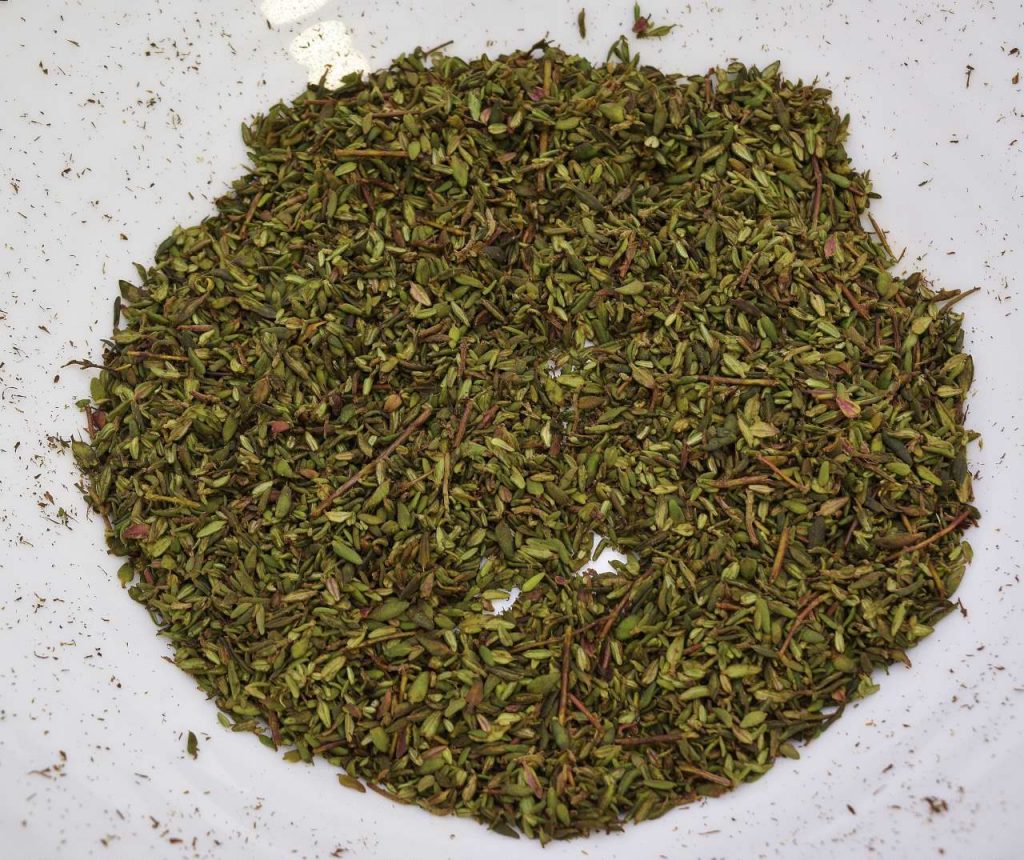
This is a neat trick. Thyme has tiny leaves securely attached to the tough branches. Picking them from the top of the stem to the bottom is such a pain that it is almost impossible to have enough to really flavor anything. Put the thyme sprigs in the food processor. Run for thirty seconds or so.
Dump the whole mess into a colander with large holes and start pushing it around. Patience, Grasshopper. After a while you will have a lot of thyme under the colander, and this stuff inside the colander:
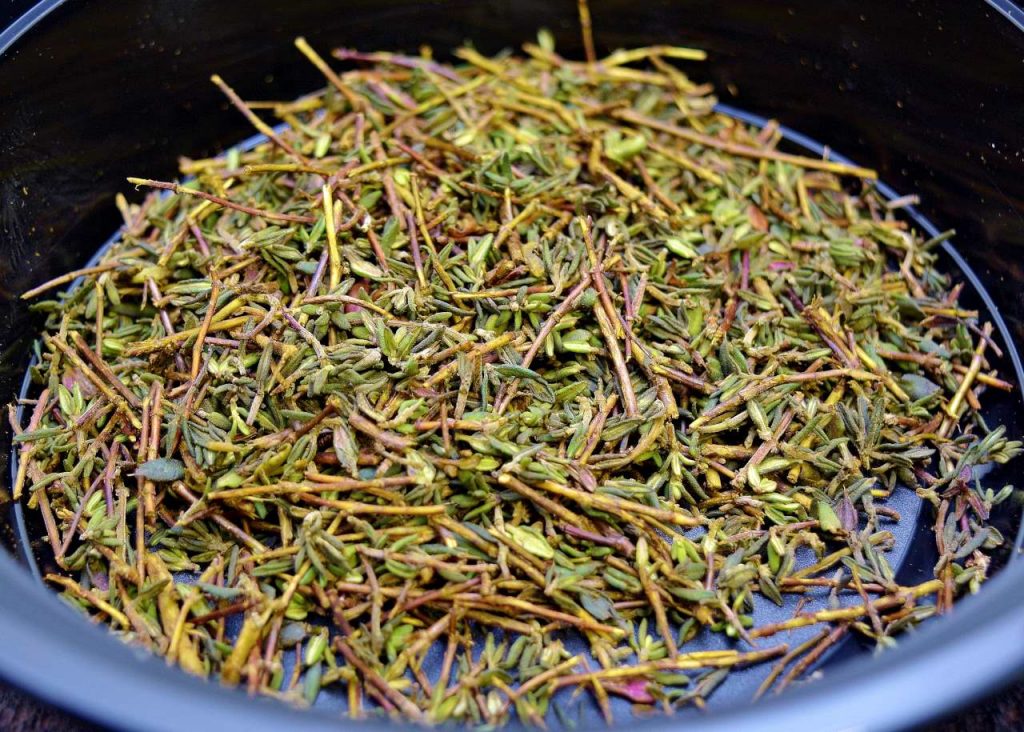
This is not useless. It is positively magical in stock. You can make gastrique out of it, too–caramelized sugar with vinegar and flavoring added. It makes a sweet and sour syrup that is great dabbed behind the ears and on the wrists. Kidding. Tasty in salad dressings, etc.
Punji stakes
Wooden skewers have a tendency to splinter and burn, and the recipes always say to soak them in water overnight. We just don’t want to wait that long after having come this far. Wrap the bamboo skewers in a clean towel, soak with water, and microwave for a minute or two. Problem solved. Careful, it’s hot.
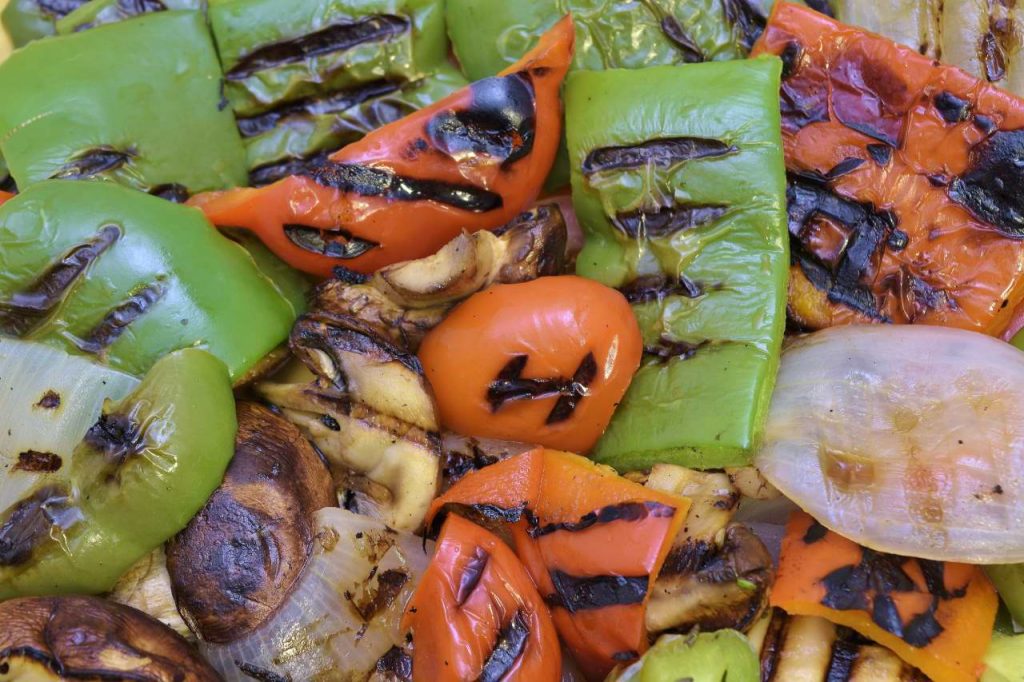
You want to get a good scorch on the peppers, but we’re not really trying to remove all that peel. We just want to darken it. If we apply oil to the bell peppers its conductivity will make them actually cook and maybe even fall apart when we try to pierce them. So, we skip the oil for the peppers. The easy way is to lay them on a sheet pan, skin side up, broil them in your oven salamander. DO NOT FLIP. I see cooks trying to sear the fleshy side too, another mindless practice that serves no useful purpose other than to ruin the pepper. They always blame the pepper.
You can torch the peppers too, that goes pretty quick. I want to actually get parallel grill marks on them so I use a cast iron grill pan with grates. I cut them into flat pieces and put a bacon press on top. Another secret shared.
Vacuum those onions.
Onions tend to be brittle so I sous vide process the whole onion @183 F/84 C for one hour and shock it in ice water. Cut off the ends, cut it in half down the spine, peel, pull apart, lubricate lightly and grill or sear in a hot pan. Then I fold them in half when I skewer them so they aren’t so floppy.
Shrooms
They say that mushrooms are 90%+ water, but they sure feel dry to me. I cut them in half, oil them lightly and grill on the flat side only, in the hot pan, again, with the bacon press–get that nice dark mark.
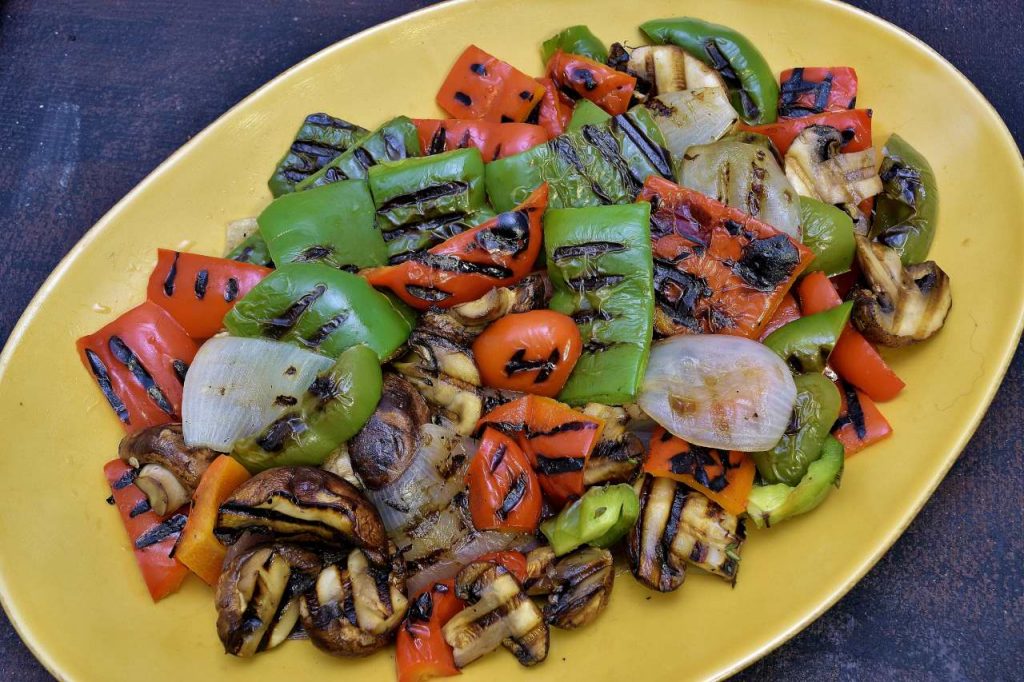
Birds on sticks
We used sous vide processed chicken for this demo, but any sous vide tenderized proteins can be used–pork, beef, lamb, even turkey. The chicken we processed @
140 F/60 C for 4 hours,
shocked in icewater to 70 F/21 C, and refrigerated at 40 F/4 C until we were ready to roll. In this state, the chicken can be kept refrigerated for at least a week without yielding quality or safety. Longer, actually, but that’s not usually necessary for most of us. I’ve been keeping a few items around for months to see if I can get something to go bad, but I have failed so far. Pretty amazing, but I don’t advocate it. For best results, always date and rotate.
After the chicken is shocked cold, cut it into pieces no larger than 0.70 oz/20 g. I prefer to wrap each one in half a slice of bacon. They get kind of clunky if you go bigger than that.
I’m on this powdered egg white kick. You can use fresh egg whites, too, but I got tired of accumulating yolks in the fridge. How many types of aioli do I need? The powdered stuff is undetectable and conveniently pasteurized. It simply replaces the albumen that leaks out of the protein, making dots in the purge. Purge should always be brought to a boil and filtered for this reason.
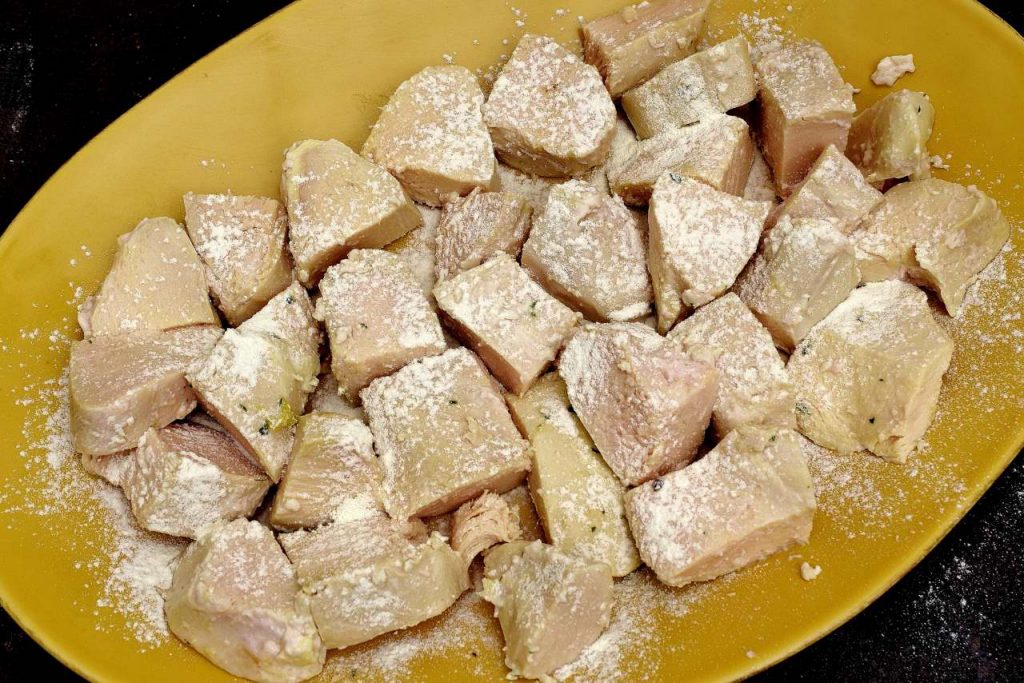
Shake a little egg white over the chicken and then spritz with a little water. The whites will reconstitute, and then…
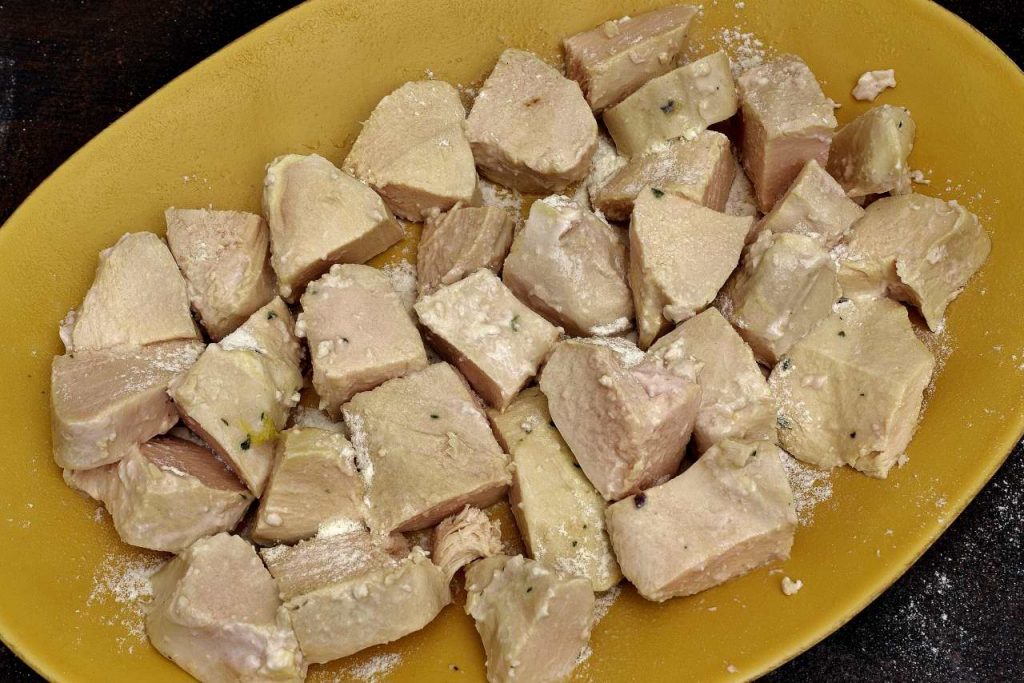
you get this.
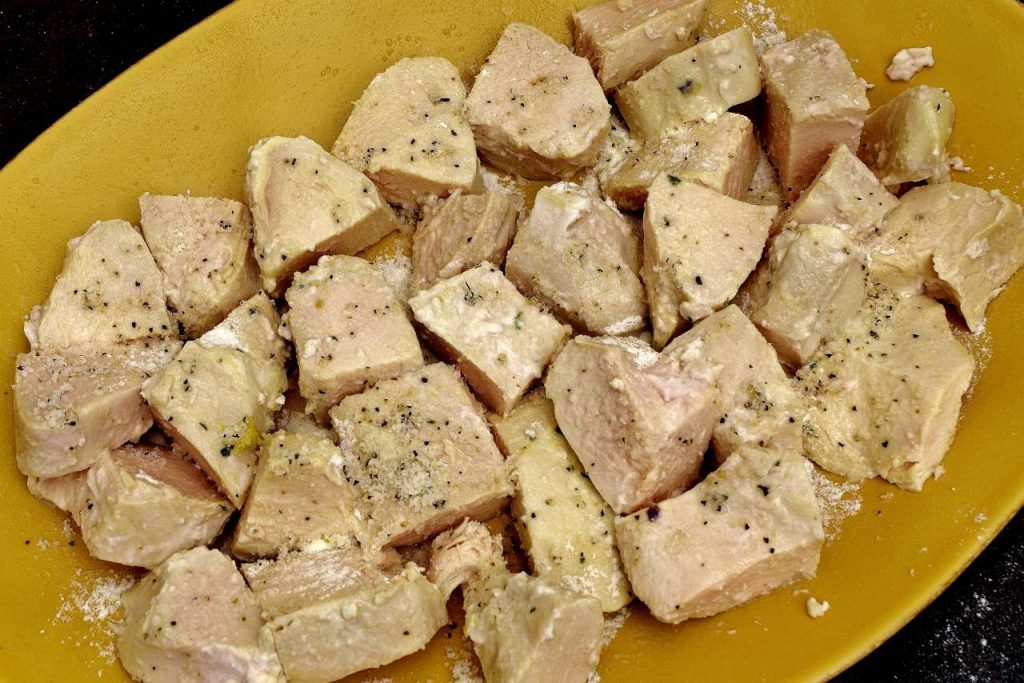
Sprinkle with kosher salt and pepper…
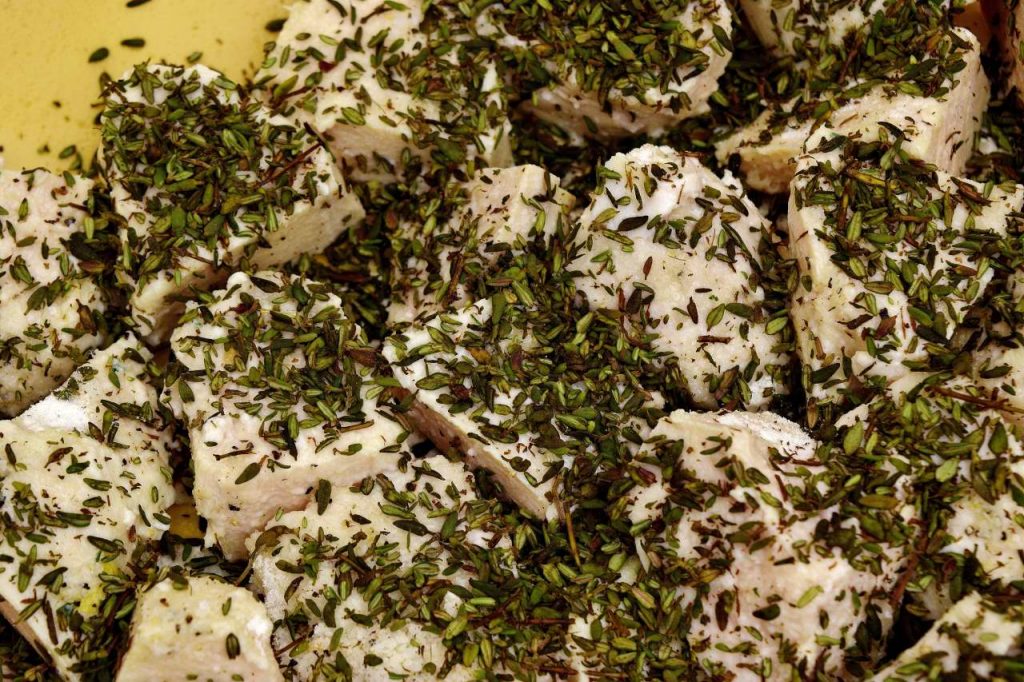
and as much thyme as you please, now that we have streamlined the de-stemming process.
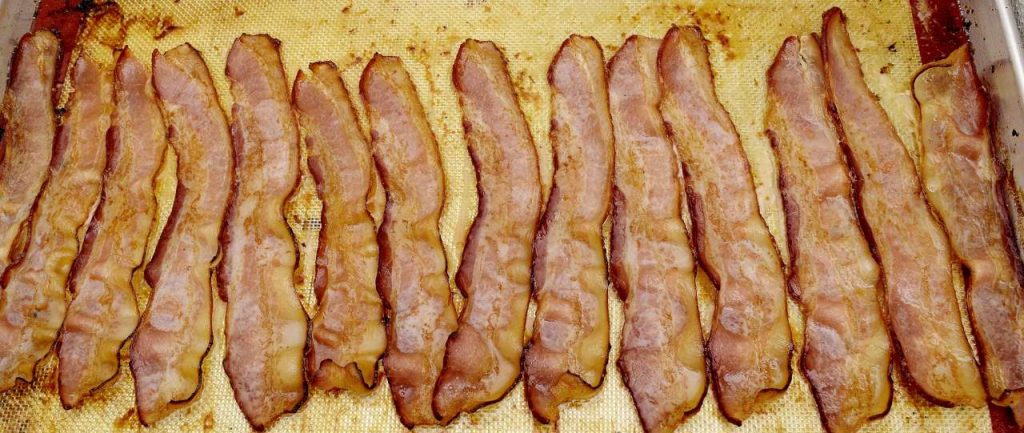
Blanch the bacon on a sheet pan. This is common practice in almost all restaurants. Among other things, it prevents curling. 350 F/176 CX 14 minutes. About. Til it looks like this:
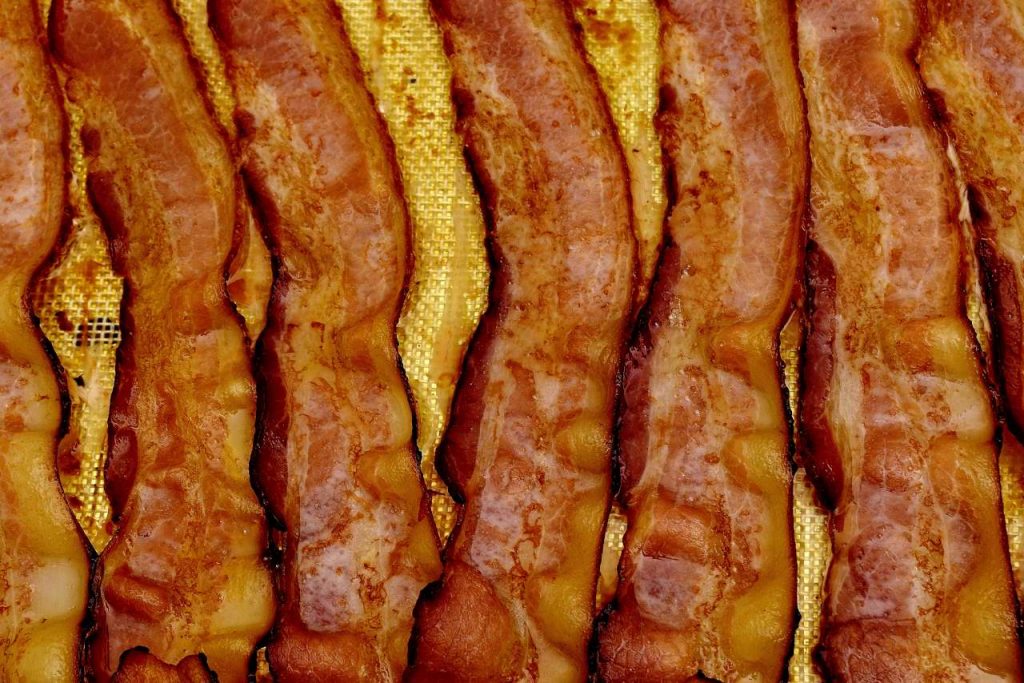
IKEA–some assembly required.
Once you have everything prepped, you assemble the brochettes. Cooks in restaurants view this as an exercise in futility and even a form of punishment: Put the meat on the stick so the customer or greedy waiter can turn right around and take it off the stick. If you’re in the doghouse with the chef, you can be sure that it will be your turn to make the brochettes next time somebody orders 150 of them for a party.
There are no strict rules for putting brochettes together, but there are a few things to consider. Alternate colors whenever possible. Try to cut or shape the components to about the same circumference–this helps so the whole thing sit flat on the grill or in the pan. Don’t push the stuff too close together because that interferes with the circulation of heat.
Little, big things.
Make one first and use it as your model. It is impossible to calculate exactly how many pieces of which you will need, so be prepared to have a few different versions. Nobody will complain–in fact, people will sort through and establish preferences for which ones have lots of peppers or no onions. They will think you did it on purpose.
Barley legal
Sous vide is great for cooking dried beans and SOME grains. I have not been able to get rice to work, but barley works really good. The great thing about sv beans and barley is they are never exposed to any friction, so you get absolutely no breakage. This doesn’t sound like a big deal, but it is. If you’re making chili or something like that, you will find yourself PURPOSELY breaking some beans to get the right consistency. It’s nice to have the choice though. Barley and most beans require three parts water to one part of the dried stuff. Very simple. I use an unsealed Ziploc Freezer Bag, and drape the opening over the edge of the Lipavi vessel…the lid holds it secure.
183 F/84 C until they are done.
Barley takes about an hour, dried beans can take considerably longer. I am going to take it on faith that our gentle readers can determine when a dried bean is cooked. Here’s a tip. The water has all been absorbed.
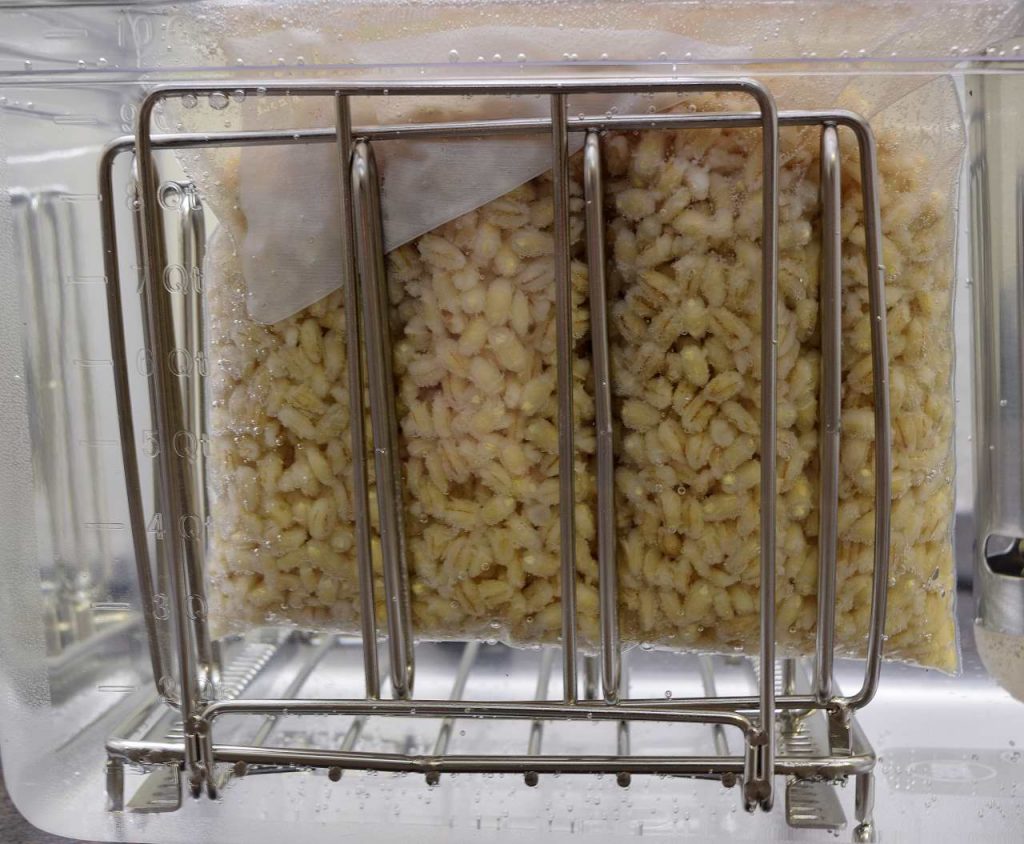
Once the barley is done, 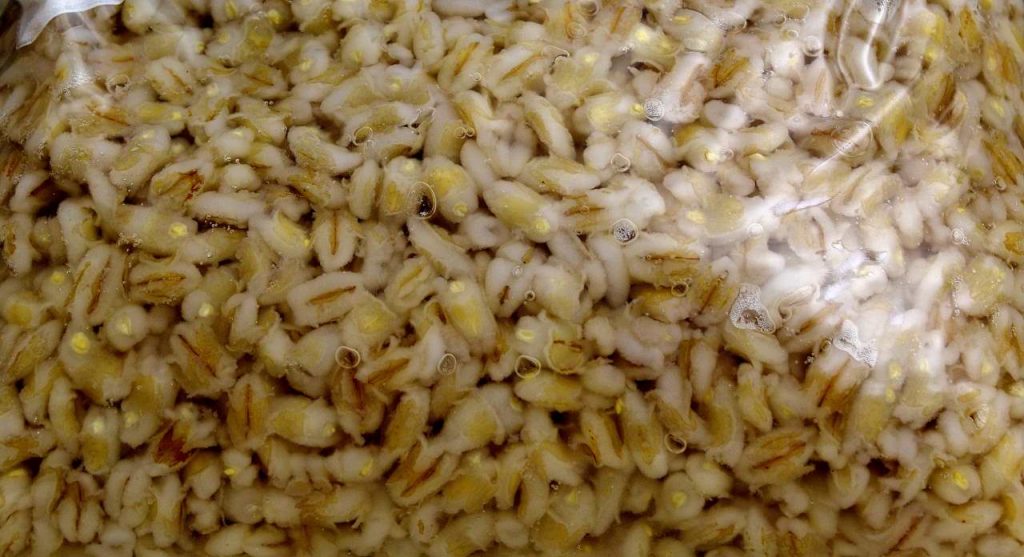
you either shock it cold or stage it into a container and season it. Add a little butter, it’s actually quite good and versatile.
Here’s some lentils I did a while back. You can see how intact they remain. Lentils ALWAYS break apart.
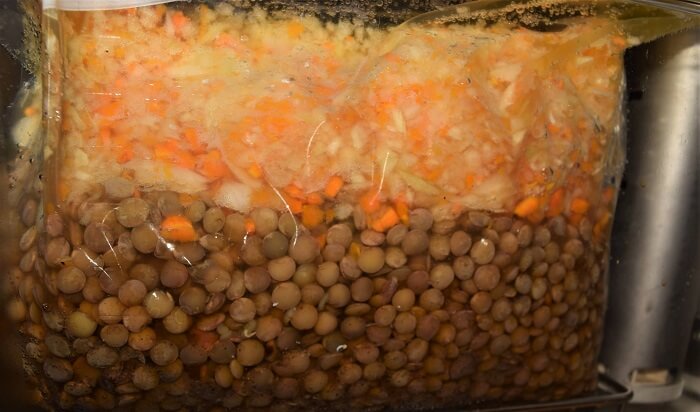
Finishing
In the old days, the tuxedo clad waiter would arrive at the table with the brochette propped up at an angle above a metal platter. He would flamboyantly douse the brochette with the cheapest brandy available and spark the whole thing into a flaming frenzy. The fury would subside and he would ceremoniously remove the bundles from the steel skewer and clumsily arrange them on a bed of rice. We thought this was very impressive at the time. In the party model, of course, the sticks are left as is. You can see I cut the cherry tomatoes in half and bookended them. Lay the barley down in the bottom for this model.
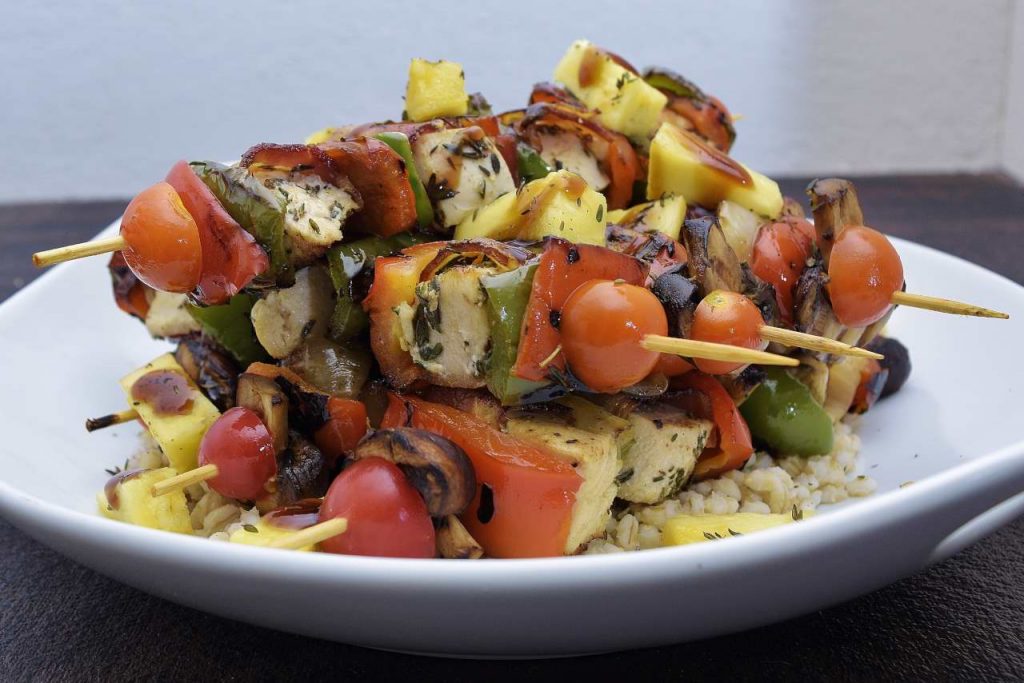
Garnish with the pineapple and drizzle one of those thickened generic teriyaki/hoisin/oyster glazes in strategic places.
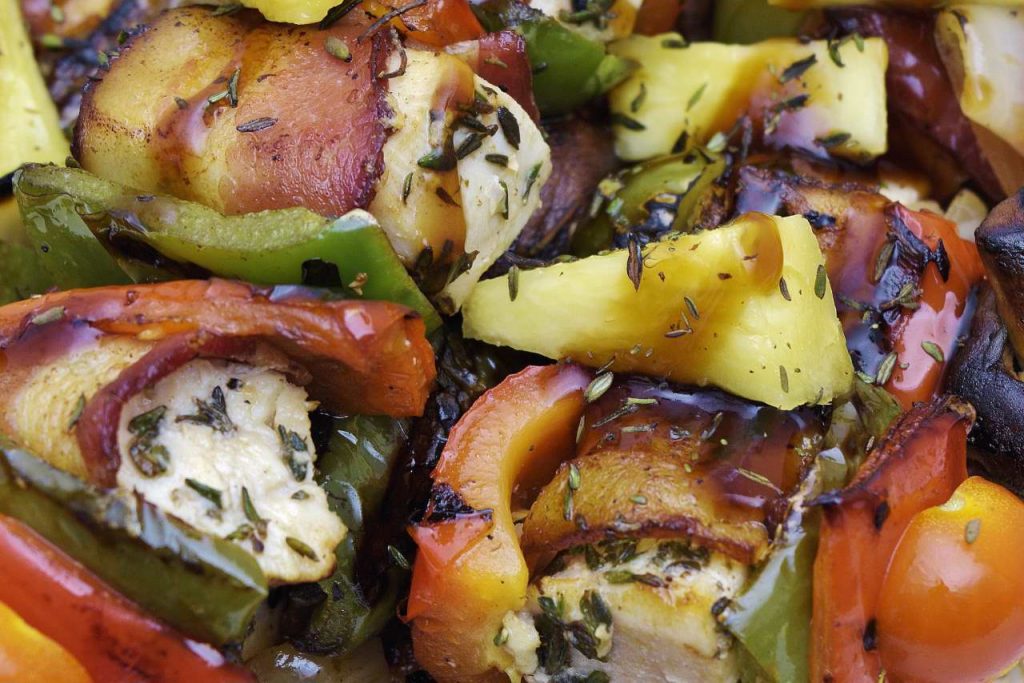
I’m sure there’s an over-thyme joke in here somewhere, but it escapes me at the moment.
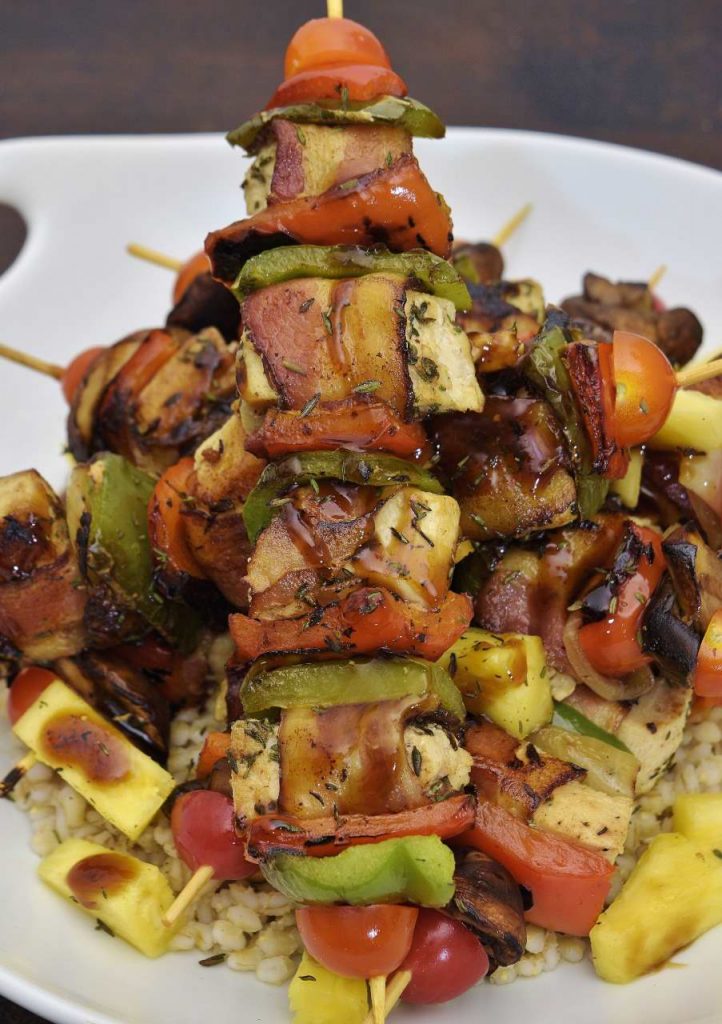
Adding a few angles encourages people to dig in.
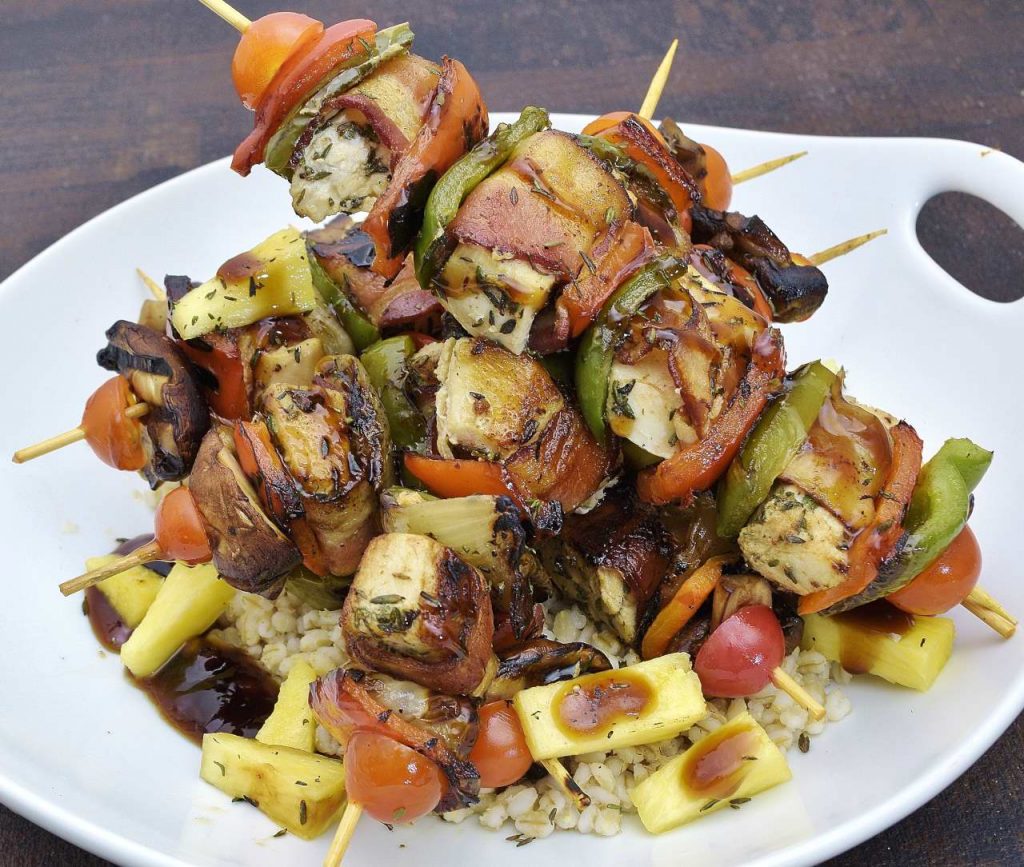
Yes. The chicken was perfect. I love sous vide.
The double retherm–just to prove a point.
We talked about how sous vide processing can pasteurize proteins while allowing them to retain the moist characteristics of “rawness.” Even though the product is safe/edible after the initial sous vide processing, it can be rethermed without becoming dry to the palate. After I finished all the brochettes for this demonstration, I refrigerated them overnight–I can only eat so much, and my wife barely weighs a hundred pounds.
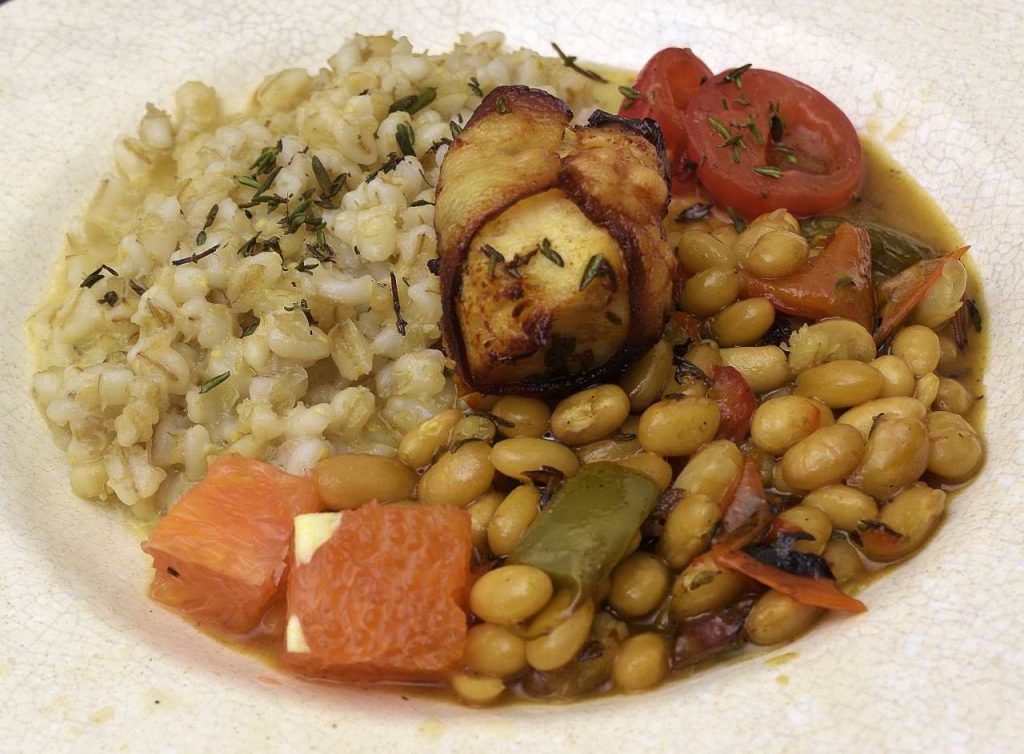
The next day, I took apart the brochettes, used the peppers and mushrooms to make a sous vide white bean soup. I rethermed the barley with a sort or “risotto” method. Adding a little water to the pan to heat the grains, I then finished with a pat of butter to emulsify the starchy kernels. I took one of the pieces of bacon wrapped chicken and deep fried it–that’s right. The bacon was secure enough to survive the process. Then I created this simple appetizer sized item, which became my wife’s dinner…
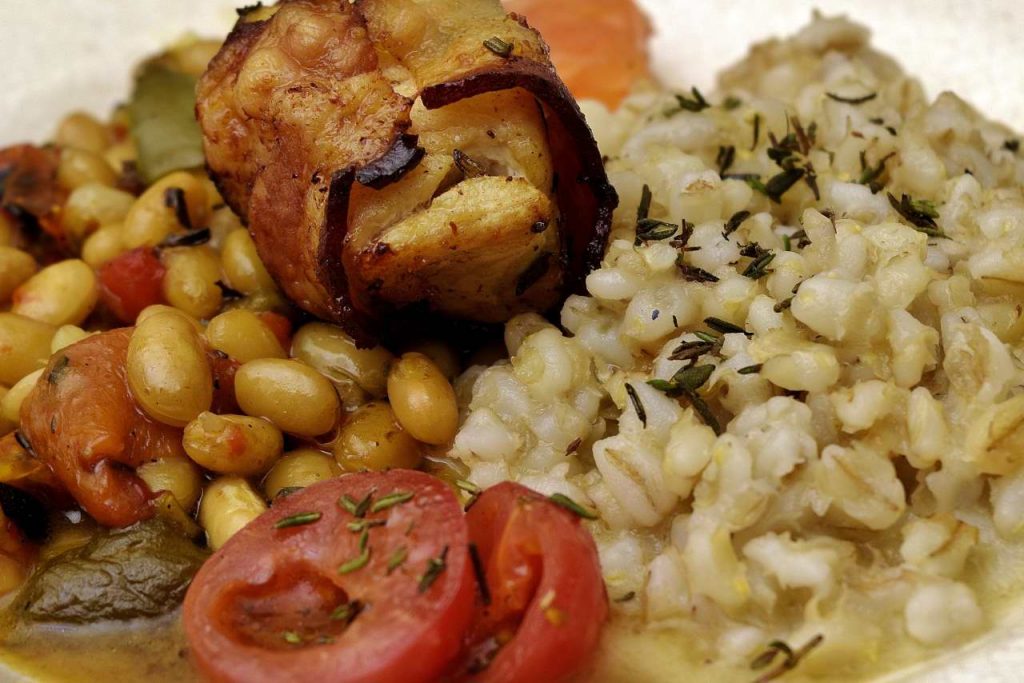
It was as if that was the original intention–even though the chicken was processed and then reheated TWICE, one would never know the difference. I love sous vide.
Norm King

